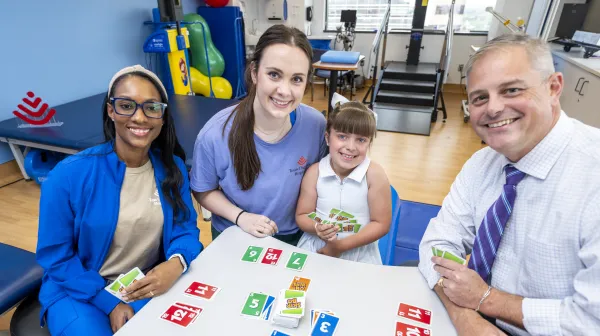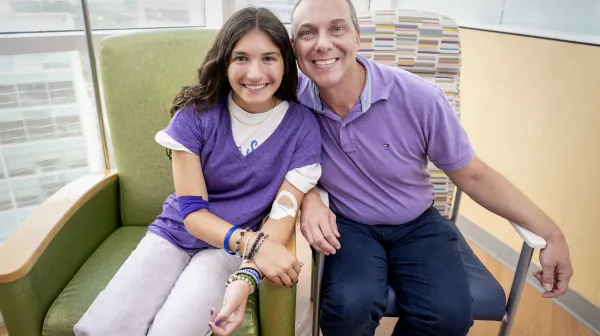Jadrien and McCall Grimes are proud parents of two adorable girls, 5-year-old Eleanor and 2-year-old Emmeline. When the couple found out they were expecting again, they were surprised and overjoyed. This time, they’d be welcoming a boy into their family. Like many expectant parents, the Grimeses couldn’t wait to meet their son, and they were excited for their girls to become big sisters to their baby brother.
Just like Jadrien’s uneventful pregnancies with their two girls, the couple didn’t expect this one to be any different. On Sept. 24, 2020, Jadrien and her husband looked forward to their baby’s 20-week anatomy scan. As they watched their son on the ultrasound screen, everything appeared to be going well until their maternal fetal medicine specialist noticed something perplexing. It would be a turning point in Jadrien’s pregnancy.
“We were told our son had a left-sided congenital diaphragmatic hernia or CDH,” Jadrien said. “Since he had a large opening in his diaphragm, his abdominal organs were pushing through the hole into his chest cavity and putting a lot of pressure on his lungs and heart, which prevented them from growing and developing properly. We were devastated and overwhelmed by this unexpected diagnosis. My maternal fetal medicine specialist provided us with options on where we should go for further evaluation. After thinking things through, it was a no brainer for us. We decided to go to Texas Children’s Hospital and were so glad to already live in Houston.”
Jadrien was referred to Texas Children’s Fetal Center® on that very same day. At 25-weeks gestation, an ultrasound and MRI were performed to determine the severity of her son’s CDH and lung volume. Over the course of two weeks, Jadrien had appointments with her fetal care team, which included Texas Children’s Obstetrician/Gynecologist-in-Chief Dr. Michael Belfort, Dr. Timothy Lee, co-director of the Fetal Center, Dr. Alireza Shamshirsaz, and Drs. Ahmed Nassr and Jimmy Espinoza. Jadrien also met with Dr. Carolyn Altman and had fetal echocardiograms to track Brady’s heart development.
“We were told our baby was on the severe side of the spectrum for CDH, which means his chance of survival were also on the low side of the spectrum,” Jadrien said. “Our medical team discussed several options with us, and told us about a research trial fetoscopic surgery that we could qualify for which could temporarily treat the CDH and could improve lung growth before our son was born. Risk of preterm labor was high, and the procedure, if we even qualified, does not always work, but the upside for his lung growth outweighed the downside for us. The hope was after his birth, his lung volume would be sufficient enough to save his life and to prevent him from going on ECMO, even though neither were a guarantee. So, at 27 weeks, although the risks were high, we proceeded with the FETO surgery to give our baby boy his best shot at making it through all of this.”
On Nov. 12, Jadrien and McCall’s son had fetal endoscopic tracheal occlusion (FETO), a minimally invasive surgery where a scope is inserted through a small incision in the mother’s abdomen and into the uterus. Guided by a camera on the end of the scope, a small inflatable balloon is placed inside the fetal trachea, where it is then inflated to temporarily obstruct the airway. Blocking the trachea enables fluid to accumulate in the fetal lungs, potentially promoting their growth and development during a period of weeks during the pregnancy. The balloon is removed in a second minimally invasive procedure prior to birth, typically around 34 weeks of pregnancy, but it varies by patient.
After the initial FETO surgery, Jadrien had weekly and then bi-weekly appointments at the Fetal Center for ultrasound monitoring to ensure the balloon was still in place, that her baby’s lungs were growing and that preterm labor was not imminent. Because the procedure temporarily blocks the baby’s airway, an unexpected delivery not at Texas Children’s would very likely be fatal. Adhering to her care team’s advice, Jadrien and her family temporarily moved closer to the Fetal Center where she could have immediate access to specialized care in case she delivered prematurely. When Jadrien was 36 weeks pregnant, surgeons removed the balloon from her baby’s trachea and the FETO was deemed an incredible success as Jadrien’s son’s right lung had flourished and grown more than ever expected. Five days later, she went into labor.
On Jan. 18, Jadrien and her husband welcomed their newborn son, Brady, who was born at Texas Children’s Pavilion for Women®. After his delivery, Brady was immediately intubated and transferred to the neonatal intensive care unit (NICU), Level IV. Texas Children’s Level IV NICU was the first to be designated by the Texas Department of State Health Services (DSHS) as a Level IV NICU, the highest level of care available for premature and critically-ill newborns in the country. One week later, pediatric surgeon Dr. Adam Vogel performed repair surgery to move Brady’s organs back into place and to close the large hole in Brady’s diaphragm. He was in the NICU for eight weeks before he could go home.
“When Brady was born, he avoided ECMO the entire time he was in the NICU, which was a huge blessing since severe CDH babies very often need the highest level of heart and respiratory support soon after delivery,” Jadrien said. “We had an incredible team of physicians and nurses from fetal to critical care to neonatology. They took wonderful care of us throughout our ordeal including Dr. Rita Shah and Dr. Jonathan Davies from neonatology. The success of the FETO, everyone’s expertise, and a lot of answered prayers, made the difference in improving our son’s outcome.”
Today, 3-month-old Brady is doing well, overall. He can now breathe on his own without any oxygen support and has been progressing well in his growth. CDH babies typically face a whole list of issues after birth and into childhood resulting from CDH, which Texas Children’s CDH Clinic also treats, but Brady is on the right track. Brady has regular follow-up visits with his pediatrician Dr. Stephanie Freeman and his care team at Texas Children’s CDH Clinic.
While this has been a tough journey to date, filled with many ups and downs, the Grimeses say their faith and the outpouring of support from so many people helped give them strength.
“Our faith in Jesus and the countless prayers in our community has definitely carried us so far in this journey,” Jadrien said. “We would not be where we are without the amazing support of our family and friends, especially Brady’s selfless grandparents, and the hundreds of people praying over Brady. Because of our support system, the FETO, Dr. Belfort and all of those wonderful people at Texas Children’s who took care of us, we are convinced that’s why our son, Brady, is a miracle baby.”
Click here to learn more about Texas Children’s Fetal Center. Click here for more information on CDH and our two clinics that provide comprehensive, multidisciplinary postnatal care for CDH patients.


